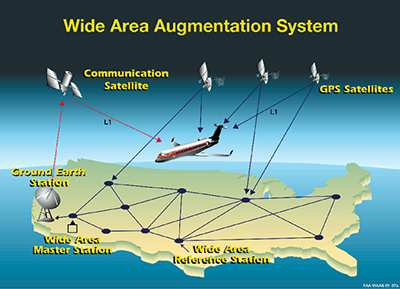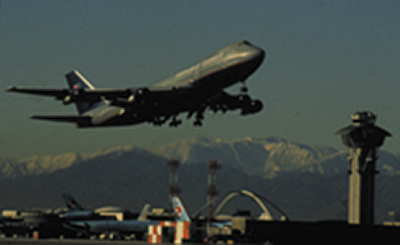Navigating the Airways
The next-generation aviation navigation system is under development, a system that makes use of Global Positioning System (GPS) satellites for aircraft to accurately define their positions.
The U.S. Federal Aviation Administration (FAA) is implementing the Wide Area Augmentation System (WAAS). WAAS is the first to greatly enhance flight safety and airline efficiency, and decrease costs associated with ground-based navigation aids. The prime contractor for the system is now Raytheon Systems Company of Lexington, Massachusetts.
Industry and government teams are working together to establish WAAS. One of the tools being utilized is software developed by NASA's Jet Propulsion Laboratory (JPL), located at the California Institute of Technology. JPL's software includes two components: Real-Time GIPSY (RTG, where GIPSY stands for GPS-Inferred Positioning System) and WADGPS Ionospheric Software (WIS, where WADGPS stands for Wide Area Differential GPS). In the case of WAAS, JPL developed state-of-the-art software for GPS applications, enabling precise orbit determination and estimation of GPS clock and atmospheric parameters--the key measurements that must be computed in real-time for operational WAAS. The precise estimators that are being installed into the FAA WAAS system are a great improvement over conventional civilian GPS accuracy and provide key integrity information in real-time, ensuring that the system provides multiple levels of safety, redundancy, and robustness for safety purposes.
The JPL software has been helpful in planning and implementing the WAAS system. The licensing program is transferring technology worth millions of dollars to the U.S. private sector from JPL. Together, these software packages are contributing to a navigation system that is expected to have a beneficial impact on the lives of millions of people, while keeping U.S. satellite tracking technology in a position of world leadership. RTG and WIS algorithms are deemed critical to the successful implementation of WAAS, a system that in the near future will provide all airliners in U.S. airspace with meter-level, real-time knowledge of position using GPS satellites.
Future WAAS benefits will include airplanes flying more direct routes, precision approaches into nearly any properly configured airport in the U.S., the gradual decommissioning of older navigation systems, which are expensive to maintain and operate, and reduced and simplified navigational equipment aboard aircraft. WAAS has the capability to provide aircraft flying in the U.S. a single system to navigate their way from takeoff to landing and from taxi to the terminal.
The 21st century airspace system will involve ground stations that receive, analyze, and refine signals from the GPS satellites and transmit the information via communication satellites to all aircraft flying within U.S. airspace. The WAAS ground stations will be located at some 35 air traffic control facilities, spread across the country.
It is anticipated that WAAS will save billions of dollars in fuel and aviation costs, while greatly enhancing aviation safety for millions of travelers. Additional systems similar to WAAS are also planned in other countries, using JPL's RTG software and WIS for precise real-time GPS corrections.

WAAS is the first aviation navigation system to greatly enhance flight safety and airline efficiency.

Courtesy of Jay Berkowitz, LAWA













